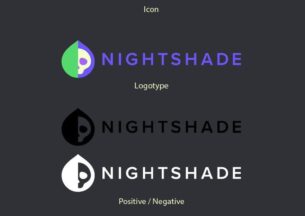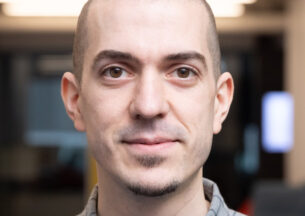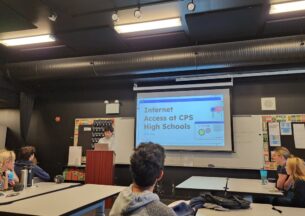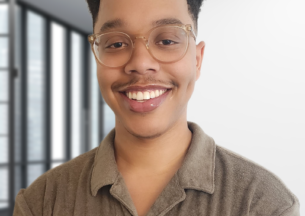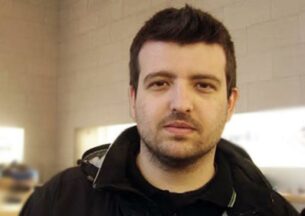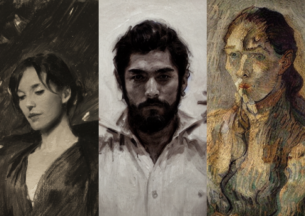UChicago / School of the Art Institute Class Uses Art to Highlight Data Privacy Dangers
By now, most people are aware that their data privacy is under siege. Unfortunately, constant security warnings and news headlines about data breaches can blur together into an abstract sense of danger, without practical takeaways. Communicating the nuances of trading off convenience for potential tracking and surveillance requires more than just words – it’s a space where art and interactivity can provide a richer, more meaningful experience.
“Surveillance Aesthetics: Provocations About Privacy and Security in the Digital Age,” a unique course co-designed by Blase Ur and Randall Landsberg at the University of Chicago and Douglas Pancoast at the School of the Art Institute of Chicago (SAIC), captures this opportunity. Launched in the fall of 2021 and taught for the second time this year, the course asks students from both institutions to collaborate in conveying modern privacy and security issues from a unique perspective, blending computer science, art, architecture, and other disciplines. The students work in cross-disciplinary groups to create an interactive artwork or exhibit that prompts viewers to think differently about their own data privacy. Groups receive input not just from their instructors and classmates, but also from curators and exhibit designers at the Museum of Science & Industry (MSI).
“We designed this class to bring together computer science students, who deeply understand the data-driven technologies impacting modern privacy, and art students, who deeply understand how to communicate ideas effectively and provocatively. I was thrilled to see how well the students worked together in making visceral the normally hidden privacy experiences of modern life,” said Blase Ur, an Assistant Professor of Computer Science at the University of Chicago.
Before the winter break, five student teams from the second offering of the course presented their work in a demo session at UChicago’s Media Arts, Data, and Design Center, located on the first floor of the John Crerar Library. The demonstrations drew upon video games, fashion design, covert photography, projection, architecture, and even fog machines to convey memorable and persistent messages about privacy and security.
Co-instructor Douglas Pancoast, an Associate Professor of Architecture at SAIC, brought the artistic perspective to the teaching team. Reflecting on the demo session, he explained, “The final review led to some really meaningful conversations. I’m always impressed with how students navigate the challenges of multi-disciplinary collaborative work. It’s not easy! I think the SAIC students will have a new perspective on privacy in computational experiences and the UChicago students will be keen to ask how conditions of privacy and security in digital space affect and inform physical space.”
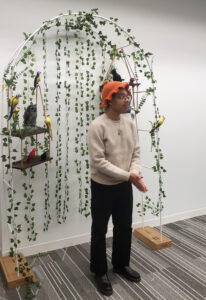 Some of the projects drew upon deception to illustrate the sneakiness of surveillance. In an exhibit called “Birds Aren’t Real,” named for a satirical conspiracy theory and created by Aarthi Koripelly, Zach Pizer, and Yifan Zou, viewers stand in front of an Instagrammable backdrop of bird statues and greenery, posing for a camera in front of them. When the photo is snapped, though, images of the subject are also captured from behind and all sides, courtesy of small cameras hidden within the birds.
Some of the projects drew upon deception to illustrate the sneakiness of surveillance. In an exhibit called “Birds Aren’t Real,” named for a satirical conspiracy theory and created by Aarthi Koripelly, Zach Pizer, and Yifan Zou, viewers stand in front of an Instagrammable backdrop of bird statues and greenery, posing for a camera in front of them. When the photo is snapped, though, images of the subject are also captured from behind and all sides, courtesy of small cameras hidden within the birds.
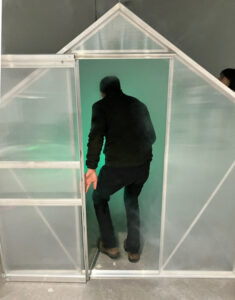 Another installation asked participants to step inside a small greenhouse filled with fog while a neon-green eye projected on the side opened and closed. As they moved within the enclosed space, secret sensors recorded their actions, with the footage revealing itself on an inner wall as the fog dissipated. The suggestion, students Ines Kang, Qianyue Liang, and Marina Takara explained, was the “illusion of privacy” in a world increasingly packed with recording devices.
Another installation asked participants to step inside a small greenhouse filled with fog while a neon-green eye projected on the side opened and closed. As they moved within the enclosed space, secret sensors recorded their actions, with the footage revealing itself on an inner wall as the fog dissipated. The suggestion, students Ines Kang, Qianyue Liang, and Marina Takara explained, was the “illusion of privacy” in a world increasingly packed with recording devices.
Students Yuntao Gao, Neal Tsai and Kristin Wu pushed back on this intrusion, designing a full-length smock that interferes with “computer vision” algorithms that identify objects in video footage. The pattern on the garment was abstracted from drone footage of the Chicago skyline, creating a new style of urban camouflage for the modern surveillance era. After creating the clothing, they tested it out on city streets, successfully concealing themselves from artificial eyes – while drawing the curious attention of human observers.
“Security is such an important issue as we’re trying to move forward with technology,” said Kathleen McCarthy, Director of Collections and Head Curator at MSI. “It was interesting to see projects that are trying to give you an awareness of being spied on, but also approaches to protect against that. It’d be really interesting to ask how completing these projects impacted how they feel about the balance between security and leveraging collective information for good.”
 Two groups turned to video games as their chosen media, designing virtual experiences with a subtle message about the course’s main topics. Gillian Nielsen, Hayley Szymanek, and William Wang presented Always Watching, where players explore a map and solve puzzles while a mysterious monster pursues them. Their clever twist: tweaking common software settings like microphone permissions, cookie options, and geolocation granularity makes the puzzles easier to solve, but also makes the monster more aggressive, gamifying the real-life compromises of online life. The game created by Sudhiksha Srinivasan and Valentina Villarroel used a dystopian setting to emphasize data security and privacy risks for activists. Players are split up at the beginning of the game, with one locked up while the other must search for them through levels that incorporate players’ actual data into the design of wanted posters and graffiti.
Two groups turned to video games as their chosen media, designing virtual experiences with a subtle message about the course’s main topics. Gillian Nielsen, Hayley Szymanek, and William Wang presented Always Watching, where players explore a map and solve puzzles while a mysterious monster pursues them. Their clever twist: tweaking common software settings like microphone permissions, cookie options, and geolocation granularity makes the puzzles easier to solve, but also makes the monster more aggressive, gamifying the real-life compromises of online life. The game created by Sudhiksha Srinivasan and Valentina Villarroel used a dystopian setting to emphasize data security and privacy risks for activists. Players are split up at the beginning of the game, with one locked up while the other must search for them through levels that incorporate players’ actual data into the design of wanted posters and graffiti.
Attendees at the demo session praised the projects for how they highlighted privacy and security matters without being overly technical or alarmist.
“Everything they did creates an emotional connection, and that’s the thing that you really remember,” said Patricia Ward, Assistant Vice President of Exhibitions and Partnerships, and Head Scientist. “It’s always really fun to see them mash up the science piece and the art, that sort of infiltration is interesting. They have very complex ideas and they’re trying to translate that into something that’s tangible and experiential.”


